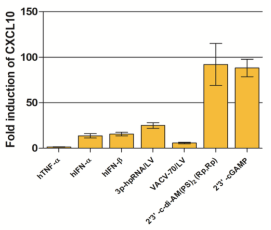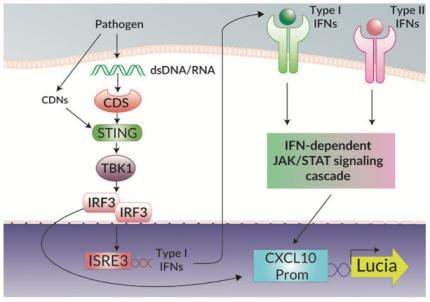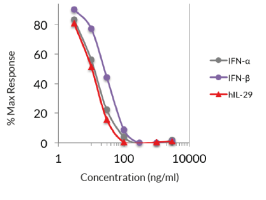THP1-Blue™ KI-IP10 Cells
-
Cat.code:
thpb-ip10kilc
- Documents
ABOUT
Examining the endogenous expression of CXCL10 (IP10)
THP1-Blue™ KI-IP10 cells have been designed to specifically examine the induction of the interferon-stimulated gene (ISG) IP10, also known as CXCL10, in response to bacterial and viral infection. Canonically, CXCL10 is known to be induced by the JAK/STAT signaling cascades activated by type I and II IFNs [1]. However, CXCL10 is also strongly induced by the activation of the STING/TBK1/IRF3 signaling axis by pathogen-derived nucleic acids and cyclic dinucleotides (CDNs) [2].
In THP1-Blue™ KI-IP10 cells the complete open reading frame of CXCL10 has been replaced with the Lucia luciferase reporter gene under the control of the endogenous promoter and thus allows the direct study of CXCL10 induction. Additionally, THP1-Blue™ KI-IP10 cells can be differentiated into macrophages, and CXCL10 expression, a classical marker of pro-inflammatory M1 macrophages, can be measured in response to stimulation. The induction of CXCL10 expression can be easily quantified by assessing the expression of the Lucia luciferase using QUANTI-Luc™ 4 Lucia/Gaussia, a Lucia and Gaussia luciferase detection reagent.
THP1-Blue™ KI-IP10 cells also stably express a secreted embryonic alkaline phosphatase (SEAP) reporter gene in response to the activation of the NF-κB pathway. Therefore, any crosstalk between the CXCL10 induction and NF-κB pathways can be studied [3]. Additionally, the independent activation of the NF-κB pathway, using an agonist such as TNF-α, is convenient for cross-sample normalization. The activation of the NF-κB pathway can be easily quantified by monitoring the activity of SEAP using QUANTI-Blue™ Solution, a SEAP detection reagent.
THP1-Blue™ KI-CXCL10 cells are resistant to blasticidin.
References:
1. Muller, M. et al., 2010. The chemokine receptor CXCR3 and its ligands CXCL9, CXCL10 and CXCL11 in neuroimmunity- a tale of conflict and conundrum. Neuropathol Appl Neurobiol. 36:368-387.
2. Motani, K. et al., 2015. DNA-Mediated Cyclic GMP-AMP Synthase-Dependent and -Independent Regulation of Innate Immune Responses. J Immunol. 194:4914‑4923.
3. Qi, X.F. et al., 2009. Essential involvement of cross-talk between IFN-gamma and TNF-alpha in CXCL10 production in human THP-1 monocytes. J Cell Physiol. 220(3):690-697.
Disclaimer: These cells are for internal research use only and are covered by a Limited Use License (See Terms and Conditions). Additional rights may be available.
SPECIFICATIONS
Specifications
Screening of PRR agonists or inhibitors
Complete RPMI 1640 (see TDS)
Verified using Plasmotest™
Each lot is functionally tested and validated.
CONTENTS
Contents
-
Product:THP1-Blue™ KI-IP10 Cells
-
Cat code:thpb-ip10kilc
-
Quantity:3-7 x 10^6 cells
- 1 ml of Normocin® (50 mg/ml)
- 1 ml of Blasticidin (10 mg/ml)
- 1 tube of QUANTI-Luc™ 4 Reagent, a Lucia luciferase detection reagent (sufficient to prepare 25 ml)
- 1 ml of QB reagent and 1 ml of QB buffer (sufficient to prepare 100 ml of QUANTI-Blue™ Solution, a SEAP detection reagent)
Shipping & Storage
- Shipping method: Dry ice
- Liquid nitrogen vapor
Storage:
DOCUMENTS
Documents
Technical Data Sheet
Safety Data Sheet
Validation Data Sheet
Certificate of analysis
Need a CoA ?







